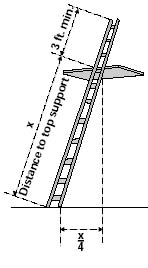Ladder Disaster
A subcontractor was working on my neighbors 12 foot high garage door and the ladder slipped out from underneath him. I heard a tremendous crash and a person moaning in agony. It was a tripod type ladder used for pruning tall trees. The pipe slid on the smooth garage floor surface and the man broke his leg. We spent the morning helping with first aid and waiting for the ambulance to arrive. He was in excruciating pain as one would imagine.
The lesson for me is use the right tool for the job, especially when it comes to heights. Be smart and always be safe. There are no short cuts in this business when it comes to safety. Go to the hardware star and buy the right tools for the job. No one will ever question an expenditure if it is safety related. We have an open credit card when it comes to job safety.
Here is a refresher on ladders from OSHA.
Falls from portable ladders (step, straight, combination and extension) are one of the leading causes of occupational fatalities and injuries.
- Read and follow all labels/markings on the ladder.
- Avoid electrical hazards! – Look for overhead power lines before handling a ladder. Avoid using a metal ladder near power lines or exposed energized electrical equipment.
- Always inspect the ladder prior to using it. If the ladder is damaged, it must be removed from service and tagged until repaired or discarded.
 Always maintain a 3-point (two hands and a foot, or two feet and a hand) contact on the ladder when climbing. Keep your body near the middle of the step and always face the ladder while climbing (see diagram).
Always maintain a 3-point (two hands and a foot, or two feet and a hand) contact on the ladder when climbing. Keep your body near the middle of the step and always face the ladder while climbing (see diagram).- Only use ladders and appropriate accessories (ladder levelers, jacks or hooks) for their designed purposes.
- Ladders must be free of any slippery material on the rungs, steps or feet.
- Do not use a self-supporting ladder (e.g., step ladder) as a single ladder or in a partially closed position.
- Do not use the top step/rung of a ladder as a step/rung unless it was designed for that purpose.
- Use a ladder only on a stable and level surface, unless it has been secured (top or bottom) to prevent displacement.
- Do not place a ladder on boxes, barrels or other unstable bases to obtain additional height.
- Do not move or shift a ladder while a person or equipment is on the ladder.
 An extension or straight ladder used to access an elevated surface must extend at least 3 feet above the point of support (see diagram). Do not stand on the three top rungs of a straight, single or extension ladder.
An extension or straight ladder used to access an elevated surface must extend at least 3 feet above the point of support (see diagram). Do not stand on the three top rungs of a straight, single or extension ladder.- The proper angle for setting up a ladder is to place its base a quarter of the working length of the ladder from the wall or other vertical surface (see diagram).
- A ladder placed in any location where it can be displaced by other work activities must be secured to prevent displacement or a barricade must be erected to keep traffic away from the ladder.
- Be sure that all locks on an extension ladder are properly engaged.
- Do not exceed the maximum load rating of a ladder. Be aware of the ladder’s load rating and of the weight it is supporting, including the weight of any tools or equipment
Recent Posts
ELECTRICAL SCHEMATIC OF THE EARTH AND SOLAR SYSTEM
Greg Poole Industrial Tests, Inc. Rocklin, CA, ...PLANCK, MUON, AND FINE STRUCTURE CONSTANT
Greg Poole Industrial Tests, Inc. Rocklin, CA, ...Electro Dynamo Theory & Schumann Resonance
Greg Poole Industrial Tests, Inc. Rocklin, CA, ...Speed of Light and Gravity
Greg Poole Industrial Tests, Inc. Rocklin, CA, ...Solar System Electrostatic Motor Theory
Greg Poole Industrial Tests, Inc. Rocklin, CA, ...
Archives
- July 2020
- January 2020
- December 2019
- November 2019
- October 2019
- September 2019
- August 2019
- September 2018
- August 2018
- July 2018
- June 2018
- May 2018
- April 2018
- March 2018
- February 2018
- January 2018
- December 2017
- November 2017
- October 2017
- March 2015
- February 2015
- December 2014
- November 2014
- October 2014
- September 2014
- August 2014
- August 2013

Recent Comments